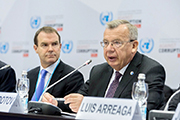Participants urged action to disrupt the criminal networks that facilitate illegal trade in wildlife and forest products at the Sixth Session of the Conference of States Parties (CoSP6) to the UN Convention against Corruption.
A conference side event recognized wildlife and forest crime as a serious threat and called for preventing corruption as part of efforts to address it.
 6 November 2015: Participants urged action to disrupt the criminal networks that facilitate illegal trade in wildlife and forest products at the Sixth Session of the Conference of States Parties (CoSP6) to the UN Convention against Corruption. A conference side event recognized wildlife and forest crime as a serious threat and called for preventing corruption as part of efforts to address it.
6 November 2015: Participants urged action to disrupt the criminal networks that facilitate illegal trade in wildlife and forest products at the Sixth Session of the Conference of States Parties (CoSP6) to the UN Convention against Corruption. A conference side event recognized wildlife and forest crime as a serious threat and called for preventing corruption as part of efforts to address it.
To tackle illegal trade in wildlife and minimize the effects of corruption, the Convention on International Trade in Endangered Species of Wild Fauna and Flora (CITES) Secretary General John Scanlon called for continued law enforcement and work to equip, train and pay civil servants, including park managers, during a presentation at the high-level event, ‘Addressing the nexus between illegal wildlife and forestry trade and corruption.’ He further recommended adopting novel approaches, such as accelerating the use of electronic permitting and other uses of information and communications technology (ICT), which he said makes it easier to detect corrupt practices.
The UN Office on Drugs and Crime (UNODC) Executive Director Yury Fedotov called for four key actions to prevent corruption and tackle wildlife crime at the event. He urged: identifying corruption risks in agencies tasked with protecting forestry and wildlife; empowering communities and others to identify and address corruption; designing strategies to mitigate risks; and demonstrating public intolerance for corruption, such as through prosecution, conviction and incarceration of responsible criminals.
In a joint statement released at the conference, Scanlon and Fedotov identify corruption as an enabler of wildlife and forest crime. The statement stresses that, “Wildlife and forest crimes are serious crimes and they must be treated as such by nations willing and committed to disrupting the international criminal networks that supply this disastrous illegal trade.” The statement elaborates on examples of corruption, such as bribing customs officials, forging hunting and logging licenses and setting poachers free.
Over 1,000 participants attended CoSP6, which convened in St. Petersburg, the Russian Federation, from 2-6 November 2015. Parties to the UN Convention against Corruption, the only legally binding universal anti-corruption instrument, meet bi-annually. [UN Press Release 3 November] [UNDOC Press Release 3 November] [UNODC Executive Director Opening Statement] [UNODC Executive Director High-level Event Statement] [UN Press Release 2 November] [UNODC Press Release 2 November] [CITES Secretary-General Presentation] [Joint Statement by UNODC Executive Director and CITES Secretary-General]